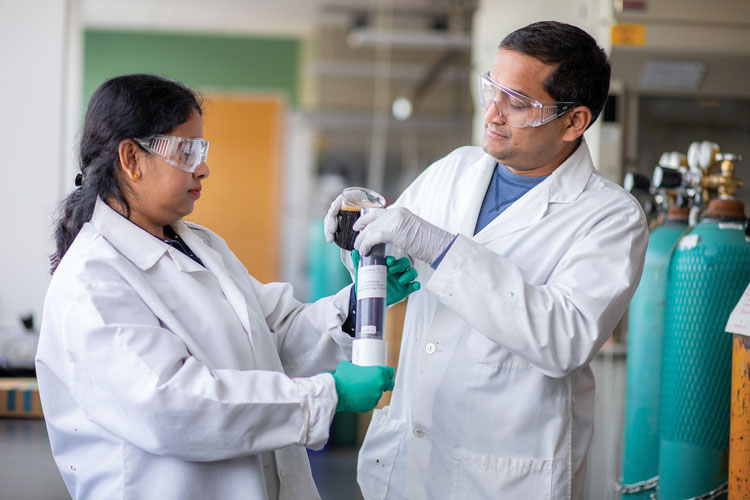The authors are all with Iowa State University. Bakshi and Banik are research scientists, Anderson is an associate professor, and Brown is a professor.

Iowa is the top pork producing state, generating almost one-third of the nation’s pork supply worth about $40.8 billion in 2020. Each of those 24 million pigs produce about 1.2 gallons of manure every day.
This abundant manure resource can be used as an inexpensive crop fertilizer, with high nitrogen (N), phosphorus (P), and potassium (K) values. Currently, 30% to 40% of nitrogen and phosphorus needed by crops are supplied by manure, and 75% and 60% of Iowa’s available nitrogen and phosphorus, respectively, come from swine manure.
The loss of nutrients
Application of fertilizers beyond what is required by crops is commonly practiced to maximize crop yield. However, overapplication results in excess nutrients ending up in water bodies where it causes algal blooms and degrades water quality. Manure can be especially problematic in this respect.
Although valued as an organic fertilizer, manure is a dilute source of nutrients, making it impractical to transport far from animal barns or feedlots. As a result, overapplication close to the source of the manure is common. Additionally, when farmers apply manure to meet recommended nitrogen or phosphorus rates for a crop, other nutrients can be over applied.
Nitrogen loss from field-applied manure usually occurs as ammonia volatilized into the atmosphere or nitrate leached into the groundwater. On the other hand, phosphorus loss occurs when this nutrient is added beyond the soil’s phosphorus-holding capacity.
Easier to transport
Recent research at Iowa State University investigated the various ways for separating and concentrating nitrogen and phosphorus from swine manure using biochar and zeolite. These concentrated forms of nutrients can be transported long distances more economically than can manure, thus helping alleviate problems in overapplication of manure.
Iowa State University has produced an engineered biochar by pretreating corn stover with iron sulfate before pyrolyzing it at high temperatures under slightly oxidizing conditions. Biochar produced in this manner can adsorb phosphorus from sources such as agricultural effluents, industrial and municipal wastewater, and livestock manure. The acidic nature of this engineered biochar slightly reduces the system pH, which helps further stabilize nitrogen as ammonium ion. The mineral zeolite is blended with the biochar to enhance adsorption of ammonium beyond what the biochar can adsorb.
Manure is a complex mixture of colloidal organic compounds and several inorganic nutrients. The charged colloidal particles compete for sorption sites on the biochar, reducing phosphorus sorption capacity of the biochar. This problem can be largely overcome by increasing the loading of biochar. The combination of engineered biochar and zeolite was found to slowly release the phosphorus to the soil, thus serving as a slow-release phosphorus fertilizer. Nitrogen was similarly adsorbed by the combination of engineered biochar and zeolite.

Although not expected from simple adsorption-desorption theories, ammonium was also slowly released to the soil. The low recovery was suspected to have happened for two reasons. First, the ammonium release was more related to the pH of the mixture, which progressed with the manure load. Second, the immobilization of ammonium nitrogen by biochar and trapping of ammonium in biochar pores are other possible theories suspected of the low release of the ammonium nitrogen from the biochar-treated manure materials.
The formation of mineral struvite and strengite was recorded for nitrogen and phosphorus recovery, which elevated in the presence of biochar. Different phases of iron minerals in the engineered biochar participated in phosphorus sorption. Whereas acidic nature of biochar reduced the ammonium loss from the recovered material, the use of zeolite increased the recovery of the nitrogen through specific adsorption to a great extent.
Weigh the benefits
Nutrient loss is a common problem for both inorganic and organic fertilizers. Thus, concentrating the manure nutrients can benefit the environment as the inorganic fertilizer price is progressing with our daily crop needs in the current fertilizer market. The additional benefit of using nutrients recovered from manure is the soil quality improvement over time, which is not feasible with inorganic fertilizer use.
The cost of this slow release fertilizer is higher than synthetic fertilizers. However, the combined benefits of nutrient recovery and protecting water quality will make this slow-release fertilizer increasingly attractive.




